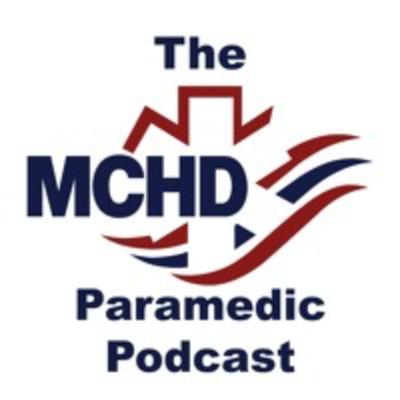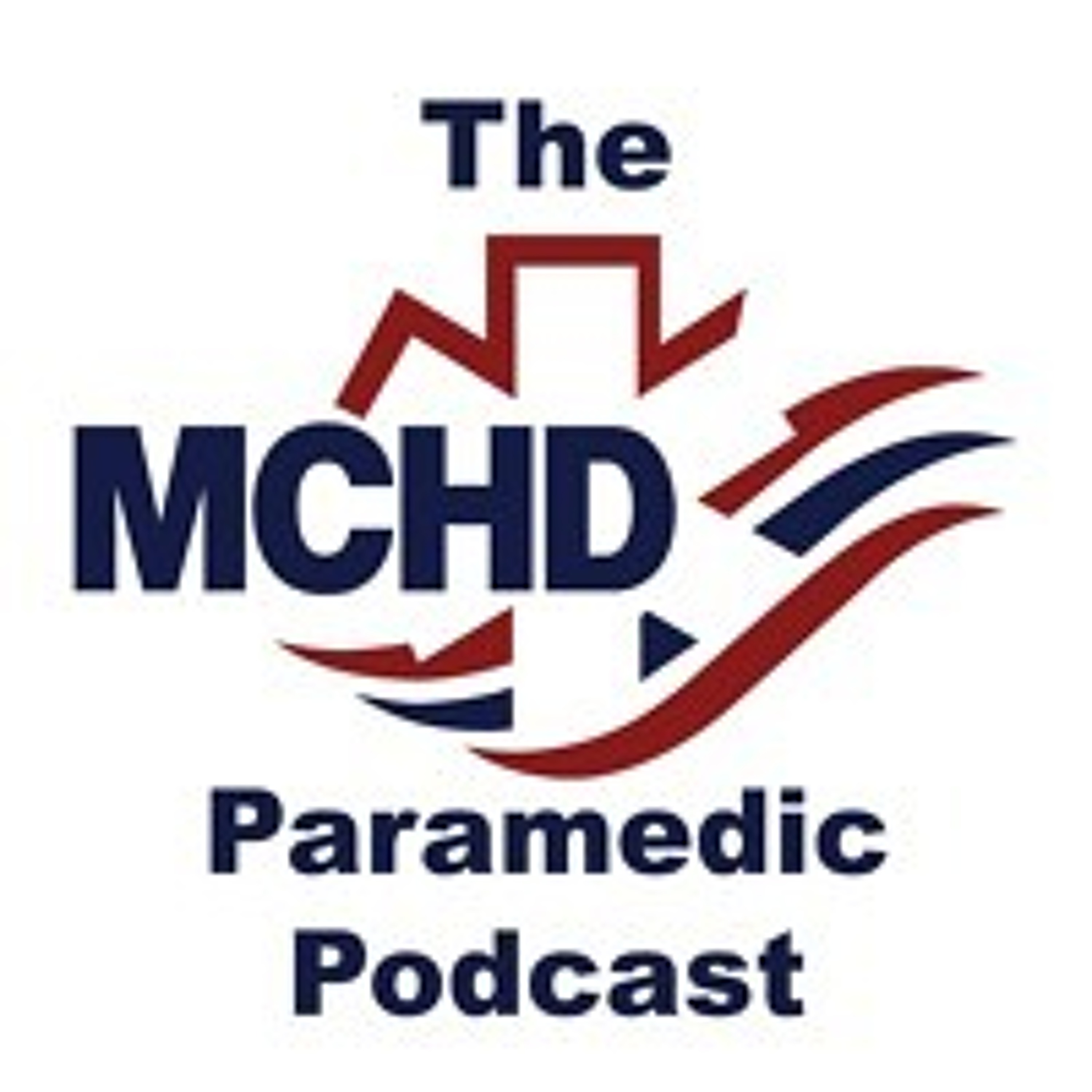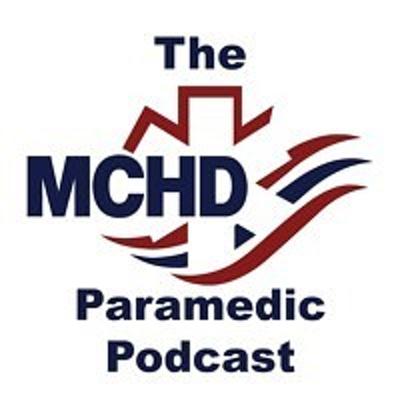Discover MCHD Paramedic Podcast
MCHD Paramedic Podcast

MCHD Paramedic Podcast
Author: Montgomery County Hospital District
Subscribed: 927Played: 22,015Subscribe
Share
© All rights reserved
Description
The MCHD Paramedic Podcast is a place for prehospital providers to discuss best practices and offer clinical insights relevant to our daily practice. MCHD Medical Director Dr. Casey Patrick invites you to explore the many aspects of prehospital care. Along the way you can expect guest appearances by some of the brightest minds that influence modern EMS.
192 Episodes
Reverse
Recently, some paramedics, obstetricians, and EMS medical directors were locked in a room and produced some fantastic collaborative prehospital guidelines for managing post-partum hemorrhage, eclampsia, and pre-eclampsia. Have a listen, take a look at the guidelines (links below), and we'll all take better care of our pregnant/post-partum patients.
REFERENCES
1. https://naemsp.org/news/now-available-new-ems-obstetric-emergency-guidelines/
There are always airway management questions floating around the Department of Clinical Services here at MCHD. "Why don't we intubate our cardiac arrest patients like we used to?" "MCHD has been hyper-focused on recording video laryngoscopy over the past year. Why?" Join the podcast crew to discuss recent EMS airway literature that helps us answer these questions and provides invaluable tips. This is part one of a two-part series.
REFERENCES
1. Galinski, M., Tazi, G., Wrobel, M., Boyer, R., Reuter, P. G., Ruscev, M., Debaty, G., Bagou, G., Dehours, E., Bosc, J., Lorendeau, J. P., Goddet, S., Marouf, K., Simonnet, B., & Gil-Jardiné, C. (2025). Risk factors for failure of the first intubation attempt during cardiopulmonary resuscitation in out-of-hospital emergency settings: What about chest compression?. Resuscitation, 214, 110623.
2. Brenne, N., Brünjes, N., Rupp, D., Sassen, M. C., Jerrentrup, A., Wulf, H., Heuser, N., & Volberg, C. (2025). Success of airway management in out-of-hospital cardiac arrest using different devices - a prospective, single-center, observational study comparing professions. Scandinavian journal of trauma, resuscitation and emergency medicine, 33(1), 109.
3. Bryan, A., Feltes, J., Sweetser, P. W., Winsten, S., Hunter, I., & Yamane, D. (2025). Hyperangulated video laryngoscopy in the emergency department: An analysis of errors and factors leading to prolonged apnea time. The American journal of emergency medicine, 95, 153–158.
We're lucky to have a special guest on this podcast episode to discuss a topic that, unfortunately, all of us in emergency care encounter all too frequently: the opiate epidemic. Peter Canning is a paramedic who has lived through the epidemic while working on the ambulance in the New England epicenter. This discussion navigates Peter's progression through newer terminology like stigma and harm reduction in an effort to provide compassionate and best-practice care for our OUD patients.
REFERENCES
1. https://www.press.jhu.edu/books/title/12438/killing-season?srsltid=AfmBOopOX3Wpf9blJDuiJbwOCKyNCACoxU2IixIMtLg1N1a-wYTGeEmr
2. https://www.press.jhu.edu/books/title/53796/friends-and-family-guide-opioid-overdose-epidemic
We're going to take our "Serial Killers" series and continue into the transition from the ambulance to the emergency department. What happens to the patient with chest pain once the ER doctor takes over? How does the workup advance? What imaging is ordered? What labs? Join us to discuss the "next 30 minutes" for the serial killer chest pain patient.
On this episode, the podcast crew discusses the recent introduction of video laryngoscopy with recording capability at MCHD. What device did you use? How did you train? What lessons have you learned? All these and more will be addressed and answered.
REFERENCES:
1. Zhao, Y., Zang, B., & Wang, Q. (2024). The Effectiveness of Bougie Use on First-Attempt Success in Tracheal Intubations. Annals of emergency medicine, 84(3), 331–332.
2. Weingart, S. D., Barnicle, R. N., Janke, A., Bhagwan, S. D., Tanzi, M., McKenna, P. J., Bracey, A., & Resuscitationists Research Group (2023). A taxonomy of key performance errors for emergency intubation. The American journal of emergency medicine, 73, 137–144.
The podcast crew takes on the topic of prehospital analgesia. What pain medication do we choose when facing a complex patient with all analgesics available? Are there better options for hypotensive patients? What about pregnancy and the elderly? On this episode, we'll walk through our MCHD pain medication options, take a moment for a BLS reminder, and discuss some specific situations where certain medications are the best fit.
REFERENCES
1. McArthur, R., Cash, R. E., Rafique, Z., Dickson, R., Crocker, K., Crowe, R. P., Wells, M., Chu, K., Nguyen, J., & Patrick, C. (2024). Intravenous Acetaminophen Versus Ketorolac for Prehospital Analgesia: A Retrospective Data Review. The Journal of emergency medicine, 67(3), e259–e267.
2. McArthur, R., Cash, R. E., Anderson, J., De La Rosa, X., Peckne, P., Hogue, D., Badawood, L., Secrist, E., Andrabi, S., & Patrick, C. (2025). Fentanyl versus nebulized ketamine for prehospital analgesia: A retrospective data review. The American journal of emergency medicine, 89, 124–128.
3. Powell, J. R., Browne, L. R., Guild, K., Shah, M. I., Crowe, R. P., Lindbeck, G., Braithwaite, S., Lang, E. S., Panchal, A. R., & Technical Expert Panel (2023). Evidence-Based Guidelines for Prehospital Pain Management: Literature and Methods. Prehospital emergency care, 27(2), 154–161.
4. Aceves, A., Crowe, R. P., Zaidi, H. Q., Gill, J., Johnson, R., Vithalani, V., Fairbrother, H., & Huebinger, R. (2023). Disparities in Prehospital Non-Traumatic Pain Management. Prehospital emergency care, 27(6), 794–799.
Lindsey Ewing (IG's The Prehospitalist) joins us to discuss updates and questions surrounding the EMS management of traumatic arrest. Sure, we must address the "reversible" causes, but what about ACLS/compressions/epinephrine? Which patients are exceptions to the rules? Lindsey had a tough case, asked some hard questions, and will provide solid answers—our favorite recipe for a jam-packed educational session.
REFERENCES
1. Witt, C. E., Shatz, D. V., Robinson, B. R. H., Campion, E. M., Shapiro, M. L., Bui, E. H., Meizoso, J. P., & Dorlac, W. C. (2025). Epinephrine in Prehospital Traumatic Cardiac Arrest-Life Saving or False Hope?. Prehospital emergency care, 1–9.
2. Breyre, A. M., George, N., Nelson, A. R., Ingram, C. J., Lardaro, T., Vanderkolk, W., & Lyng, J. W. (2025). Prehospital Trauma Compendium: Prehospital Management of Adults with Traumatic Out-of-Hospital Circulatory Arrest - A Joint Position Statement and Resource Document of NAEMSP, ACS-COT, and ACEP. Prehospital emergency care, 1–15.
3. https://www.anzcor.org/assets/anzcor-guidelines/guideline-11-10-1-management-of-cardiac-arrest-due-to-trauma-253.pdf
We're joined by Dallas-area cardiac arrest management thought leaders from Best EMS and Parker County Hospital District to discuss the Resuscitation Academy. Where did this thing start? How can you and your service benefit? What RA lessons have we implemented here at MCHD? Learn how to improve your cardiac arrest survival rates without breaking the bank.
REFERENCES
1. https://www.resuscitationacademy.org
Orthostatic vitals are taught throughout medical training as a quick and easy way to assess patient volume status objectively. We also frequently see these documented in MCHD charts. Is there any evidence that orthostatics help our clinical decision-making? Has anyone ever evaluated their use in EMS? Could standing a patient to check their heart rate actually be harmful? Join the podcast crew as they address these questions and more.
REFERENCES
1. White, JL, Hollander, JE, Chang, AM, et al. (2019). Orthostatic vital signs do not predict 30-day serious outcomes in older emergency department patients with syncope: A multicenter observational study. The American journal of emergency medicine, 37(12), 2215–2223.
2. Shen W, Sheldon R, Yancy C, et al. 2017 ACC/AHA/HRS Guideline for the Evaluation and Management of Patients With Syncope: A Report of the American College of Cardiology/American Heart Association Task Force on Clinical Practice Guidelines and the Heart Rhythm Society. Journal of The American College Of Cardiology. August 1, 2017;70(5):e39-e110. Available from: MEDLINE, Ipswich, MA. Accessed May 1, 2018.
3. Cohen E, Grossman E, Sapoznikov B, et al. Assessment of orthostatic hypotension in the emergency room. Blood Press. 2006;15(5):263-267.
4. Aronow WS, Lee NH, Sales FF, Etienne F. Prevalence of postural hypotension in elderly patients in a long-term health care facility. Am J Cardiol. 1988;62(4):336.
5. Ooi WL, Barrett S, Hossain M, et al. Patterns of orthostatic blood pressure change and their clinical correlates in a frail, elderly population. JAMA. 1997;277(16):1299-1304.
On today's episode, we're lucky to have a couple of special guests to discuss prehospital transcutaneous pacing. Medics turned medical students and EMS researchers, Josh Kimbrell and Judah Kreinbrook recently published a case series decsribing EMS pacing capture. Like many of our favorite topics this came from a paramedic asking a clinical question with loads of dogma and little evidence. What they found should motivate us all to be skeptical when it comes to determining if TCP is actually working.
REFERENCES
1. https://www.mchd-tx.org/media/podcasts/TCP-Podcast-Figures.pdf
2. Kimbrell, J., Kreinbrook, J., Poke, D., Kalosza, B., Geldner, J., Shekhar, A. C., Miele, A., Bouthillet, T., & Vega, J. (2024). False Electrical Capture in Prehospital Transcutaneous Pacing by Paramedics: A Case Series. Prehospital emergency care, 28(7), 928–936.
3. https://www.ems12lead.com/post/tcp-in-transit-part-i
4. https://www.ems12lead.com/post/transcutaneous-pacing-part-2
5. https://www.ems12lead.com/post/transcutaneous-pacing-part-3
We often discuss "one in a million" and "once in a career" cases in emergency medicine and EMS, and do we ever have one of those for you in this episode! MCHD Captain, Jason Jones, joins Dr. Patrick to discuss an exeedingly rare STEMI/chest pain presentation with lessons that we can all apply to our daily care.
REFERENCES
1. https://www.mchd-tx.org/media/podcasts/SITUS-Fig-1.pdf
2. https://www.mchd-tx.org/media/podcasts/SITUS-Fig-2.pdf
3. https://montgomerycountypolicereporter.com/mchd-celebrates-survival-of-one-in-a-million-patient-first-responders-please-read/
4. https://pubmed.ncbi.nlm.nih.gov/34317454/
This is a special edition of the MCHD Paramedic Podcast. Ginger Locke, of the absolutely amazing Medic Mindset podcast, invited Dr. Patrick on to discuss rate control of rapid atrial fibrillation in the prehospital setting. She was gracious enough to share the audio for a dual release. This episode has been out in the world on Medic Mindset for a couple of months, but we wanted to offer it to our MCHD Paramedic Podcast listeners as well. Also, like, subscribe to and follow Medic Mindset wherever you listen to podcasts.
REFERENCES
1. https://medicmindset.com
2. Elam, K., & Bolar-Softich, K. L. (1997). Dilemmas in the acute pharmacologic treatment of uncontrolled atrial fibrillation. The American journal of emergency medicine, 15(4), 418–419.
3. Abarbanell, N. R., & Marcotte, M. A. (1997). Prehospital use of intravenous diltiazem (cardizem Lyo-Ject) in the treatment of rapid atrial fibrillation. The American journal of emergency medicine, 15(6), 618–619.
4. Abarbanell, N. R., Marcotte, M. A., Schaible, B. A., & Aldinger, G. E. (2001). Prehospital management of rapid atrial fibrillation: recommendations for treatment protocols. The American journal of emergency medicine, 19(1), 6–9.
5. Wang, H. E., O'connor, R. E., Megargel, R. E., Schnyder, M. E., Morrison, D. M., Barnes, T. A., & Fitzkee, A. (2001). The use of diltiazem for treating rapid atrial fibrillation in the out-of-hospital setting. Annals of emergency medicine, 37(1), 38–45.
6. Luk, J. H., Walsh, B., & Yasbin, P. (2013). Safety and efficacy of prehospital diltiazem. The western journal of emergency medicine, 14(3), 296–300.
7. Rodriguez, A., Hunter, C. L., Premuroso, C., Silvestri, S., Stone, A., Miller, S., Zuver, C., & Papa, L. (2019). Safety and Efficacy of Prehospital Diltiazem for Atrial Fibrillation with Rapid Ventricular Response. Prehospital and disaster medicine, 34(3), 297–302.
8. Fornage, L. B., O'Neil, C., Dowker, S. R., Wanta, E. R., Lewis, R. S., & Brown, L. H. (2024). Prehospital Intervention Improves Outcomes for Patients Presenting in Atrial Fibrillation with Rapid Ventricular Response. Prehospital emergency care, 28(7), 910–919.
MCHD recently rolled out Ceftriaxone for long-bone open fracture care. The podcast crew welcomes our new assistant medical director, Dr. Mike DePasquale, to discuss some background evidence and danger spots within this protocol.
REFERENCES:
Lack, W. D., Karunakar, M. A., Angerame, M. R., Seymour, R. B., Sims, S., Kellam, J. F., & Bosse, M. J. (2015). Type III open tibia fractures: immediate antibiotic prophylaxis minimizes infection. Journal of orthopaedic trauma, 29(1), 1–6.
Johnson, J. P., Oliphant, B. W., Dodd, J., Duckworth, R. L., Goodloe, J. M., Lyng, J. W., Sagraves, S. G., & Fischer, P. E. (2024). Prehospital Antibiotic Administration for Suspected Open Fractures: Joint COT/OTA/ACEP/NAEMSP/NAEMT Position Statement. Prehospital emergency care, 28(8), 1063–1067.
Muniz, A. D., Gregorio, D. J., Studebaker, S. A., Peth, A. M., Camacho, C. G., Williams, B., Kupas, D. F., & Brown, L. H. (2024). Time Savings and Safety of EMS Administration of Antibiotics for Open Fractures. Prehospital emergency care, 28(8), 1046–1052.
We recently implemented a "push-dose" norepinephrine protocol at MCHD and have already learned some valuable lessons. Join us for some vasopressor pharmacology and protocol review, accompanied by some of our new teaching points that have arisen following the protocol's release into the wild.
REFERENCES:
1. Berkenbush, M., Singh, L., Sessa, K., & Saadi, R. (2024). Scoping Review: Is Push-Dose Norepinephrine a Better Choice? The western journal of emergency medicine, 25(5), 708–714.
2. Permpikul, C., Tongyoo, S., Viarasilpa, T., Trainarongsakul, T., Chakorn, T., & Udompanturak, S. (2019). Early Use of Norepinephrine in Septic Shock Resuscitation (CENSER). A Randomized Trial. American journal of respiratory and critical care medicine, 199(9), 1097–1105.
Dr. Patrick is joined by MCHD District Chief Kelcie Adams to discuss the role of clinical case reviews at MCHD. Why are these so important, and what's the big deal? Kelcie is brave enough to use one of her recent calls as an example of the positives that can come if we get past our egos and allow ourselves to have insight for future cases.
We're working on a new series focusing on high-yield pharmacology reviews. Dr. Patrick starts us off with some background, mechanism of action discussion and common uses for magnesium sulfate. Mag is one of the true pharmacologic swiss army knives of emergency care.
REFERENCES
1. Touyz RM, de Baaij JHF, Hoenderop JGJ. Magnesium Disorders. N Engl J Med. 2024 Jun 6;390(21):1998-2009. doi: 10.1056/NEJMra1510603.
Our final entry into the EKG Manifesto series moves into the STEMI/OMI world of acute coronary occlusion. Who do we activate and why? Where is the STEMI paradigm headed? Join Dr. Patrick and Dr. Dickson to refresh your EKG knowledge.
REFERENCES
1. https://www.emdocs.net/ecg-pointers-stemi-equivalents-from-the-american-college-of-cardiology/
One of the most fear-inducing procedures in all of emergency care is the surgical cricothyrotomy. Dr. Al Lulla from Dallas Fire joins the podcast to discuss our recent collaboration on a retrospective look at MCHD's surgical airway experience over the past decade. Can paramedics successfully perform cricothyrotomies? Who needs surgical airway placement in the field? What can we learn for our next "can't oxygenate/can't ventilate" scenario?
REFERENCES
1. https://youtu.be/wVQFJR7qmrQ?si=QBUfJd_7oZ3vmEpR
2. Lulla A, Dickson R, Wells M, Gilbert M, Rogers Keene K, Patrick C. Prehospital Surgical Cricothyrotomy in a Ground-Based 9-1-1 EMS System: A Retrospective Review. Prehosp Disaster Med. 2024 Apr 23:1-4.
Applied EKG interpretation is often a difficult task in EMS and emergency medicine education. Getting bogged down in minutiae can obscure the patient. While an understanding of EKG foundational physiology is an absolute must, consideration of how to combine the 12-lead and patient presentation is vital as well. Join the podcast crew as they start at the end with the killer/"can't miss" EKG patterns and combine those with common chief complaints. Hopefully, this framework will click for you. In Part 2 of this series, we'll discuss bradycardias and tachycardias.
REFERENCES
1. https://www.youtube.com/watch?v=UXh8PS9dtmo
We've initiated a multi-pronged, system wide overhaul of our agitation management at MCHD. This included a move to fixed-dose ketamine for the severely agitated patients. Evidently we weren't the only ones thinking of this as there is exciting new data from Buffalo supporting this approach. Join the podcast crew as they review the recent literature and MCHD protocol changes.
REFERENCES
1. O'Brien MC, Kelleran KJ, Burnett SJ, Hausrath KA, Kneer MS, Nan N, Ma CX, McCartin RW, Clemency BM. Fixed dose ketamine for prehospital management of hyperactive delirium with severe agitation. Am J Emerg Med. 2024 Jul;81:10-15.








Are there any shown notes?
Quite ironic that the opioid MD specialist is named Dr. Snow ;--)